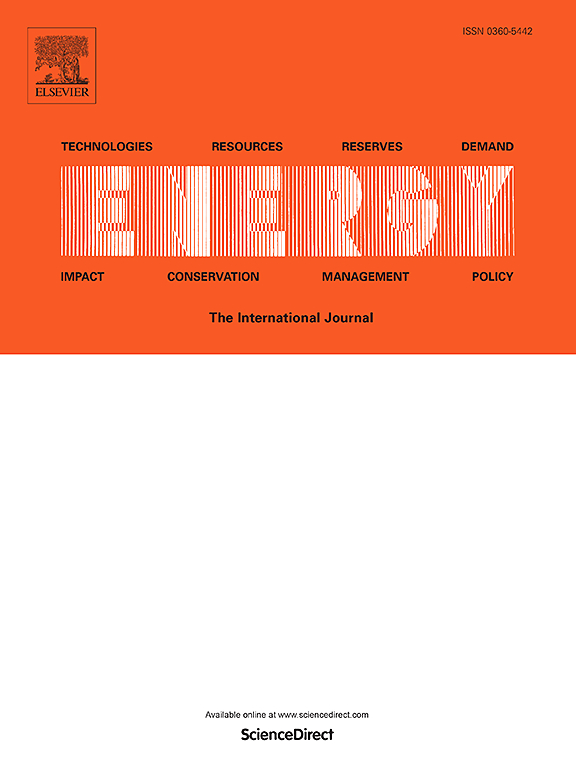Interplay of topography, wettability, and confinement controls boiling of water over functionalized graphene interfaces
IF 9
1区 工程技术
Q1 ENERGY & FUELS
引用次数: 0
Abstract
Functionalized graphene offers tunable properties that can enhance energy efficiency in applications like heat exchangers and power generation. At the nanoscale, graphene's features may lower the energy barrier for bubble nucleation, improving heat transfer by facilitating frequent bubble formation at lower superheat. However, the interplay between nanoconfinement, surface features, temperature, and wettability is complex, influencing bubble dynamics non-trivially. We use molecular simulations to explore the boiling dynamics of water on pristine and defective graphene surfaces within confined spaces. We investigate the effects of varying substrate temperatures and wettability conditions by confining water between graphene sheets with different topographical features. On wetting surfaces, cavity features yield the highest heat transfer rates, followed by surfaces with protrusions and pristine graphene. In contrast, non-wetting surfaces exhibit a more complex relationship between surface features, wettability, and confinement. Our findings highlight the crucial role of wettability and topology in boiling on a realistic graphene surface, which is rarely atomically smooth. This offers new insights into nanoscale thermal management and energy transfer. The results suggest that functionalized graphene can be tailored to optimize heat transfer efficiency, providing a promising approach for enhancing energy efficiency in thermal systems without even having precise control over the nanoscopic architecture. By understanding these mechanisms, we can develop more effective strategies for thermal energy management using graphene-based technologies.
地形、润湿性和约束的相互作用控制了水在功能化石墨烯界面上的沸腾
功能化石墨烯提供了可调特性,可以提高热交换器和发电等应用的能源效率。在纳米尺度上,石墨烯的特性可以降低气泡成核的能量垒,通过在较低的过热度下促进气泡的频繁形成来改善传热。然而,纳米约束、表面特征、温度和润湿性之间的相互作用是复杂的,对气泡动力学的影响是非平凡的。我们使用分子模拟来探索在有限空间内原始和有缺陷的石墨烯表面上水的沸腾动力学。我们通过在具有不同地形特征的石墨烯片之间围水来研究不同衬底温度和润湿性条件的影响。在湿润的表面上,空腔特征产生最高的传热率,其次是具有突起和原始石墨烯的表面。相比之下,非润湿表面在表面特征、润湿性和约束之间表现出更复杂的关系。我们的发现强调了润湿性和拓扑结构在真实的石墨烯表面上沸腾的关键作用,石墨烯表面很少是原子光滑的。这为纳米级热管理和能量转移提供了新的见解。结果表明,功能化石墨烯可以定制以优化传热效率,为提高热系统的能源效率提供了一种有前途的方法,甚至无需精确控制纳米级结构。通过了解这些机制,我们可以利用石墨烯为基础的技术开发更有效的热能管理策略。
本文章由计算机程序翻译,如有差异,请以英文原文为准。
求助全文
约1分钟内获得全文
求助全文
来源期刊

Energy
工程技术-能源与燃料
CiteScore
15.30
自引率
14.40%
发文量
0
审稿时长
14.2 weeks
期刊介绍:
Energy is a multidisciplinary, international journal that publishes research and analysis in the field of energy engineering. Our aim is to become a leading peer-reviewed platform and a trusted source of information for energy-related topics.
The journal covers a range of areas including mechanical engineering, thermal sciences, and energy analysis. We are particularly interested in research on energy modelling, prediction, integrated energy systems, planning, and management.
Additionally, we welcome papers on energy conservation, efficiency, biomass and bioenergy, renewable energy, electricity supply and demand, energy storage, buildings, and economic and policy issues. These topics should align with our broader multidisciplinary focus.
 求助内容:
求助内容: 应助结果提醒方式:
应助结果提醒方式:


